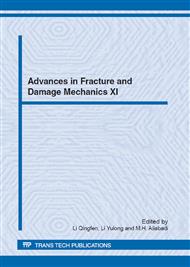p.481
p.485
p.489
p.493
p.497
p.501
p.505
p.509
p.513
Modelling Micro-Damage in Granular Solids
Abstract:
The prediction of the spacing and opening of cracks in asphalt or concrete pavements, and particularly in airports (runway, taxiway and apron) is important for the durability assessment. A basic problem is the spacing of parallel planar cracks from a half space surface, approached and solved by numerous authors by means of macro-scale computational models. The calculated values of crack spacing are in relatively good agreement with the values reported in observations on asphalt concrete pavements. The constituents of granular solids are, fundamentally, made of grain in contact and, these materials are highly discontinuous and non-homogeneous with two or three phases (solid, voids with air or water), and finally binding among solid parts. The aim of this paper is to suggest a micromechanical approach in granular material solids, focusing the attention on a simple RVE (representative volume element) based on two rigid particles linked through an adhesive material (bitumen). Our final aim is to propose a micro-damageability parameter (interface loss) supposing the adhesion decreasing under the action of prescribed tangential and normal relative displacement. The reduction is attributed by progressive damage and comes with energy dissipation and moreover we assume unilateral contact conditions for normal displacement and Coulomb friction for the tangential displacement.
Info:
Periodical:
Pages:
497-500
Citation:
Online since:
November 2012
Price:
Сopyright:
© 2013 Trans Tech Publications Ltd. All Rights Reserved
Share:
Citation:


